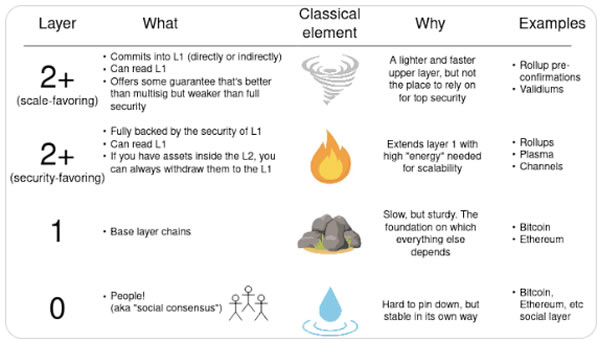Ethereum co-founder Vitalik Buterin has sparked discussion on how various layer-2 scaling solutions are classified, claiming that the blockchain’s validiums are not genuine rollup solutions.
On Jan. 16, Buterin agreed with a comment posted to X (formerly Twitter) by Daniel Wang, the founder of the Ethereum rollup solution Taiko, who said if an Ethereum rollup uses another data chain for data availability — such as the modular blockchain Celestia — then it’s an Ethereum validium.
“This is correct,” Buterin replied. “The core of being a rollup is the unconditional security guarantee: you can get your assets out even if everyone else colludes against you.”
“You can’t get that if data availability is dependent on an external system,” he added.
If an Ethereum rollup uses other data chain for DA, it is an Ethereum validium. https://t.co/bFMfUNYlLf
— danielwang.eth (@daniel_taikoxyz) January 16, 2024
Validium is an Ethereum scaling solution using zero-knowledge proofs to enable off-chain transactions while relying on Ethereum’s mainnet for security and verification.
Unlike zero-knowledge rollups, which batch transactions on a layer-2 network and verify them on a layer 1 like Ethereum, validium networks do not post transaction data to an L1. Instead, validiums post cryptographic proof that transactions are valid, a setup that aims to achieve higher scalability as full transaction data doesn’t need to be stored on-chain.
However, validiums rely on operators to honestly post proofs and can have reduced data availability compared to rollups.
Networks like Celestia use a modular blockchain made up of data availability layers and validation layers — the latter using validiums to enable fast and private transactions.
In a Jan. 16 post on the decentralized social media Warpcast, Buterin shared a diagram proposing an adjustment to some of the terminologies, such as “security-favoring” and “scale-favoring” to “strong” vs. “light” to be “more succinct.”
Buterin’s proposed Ethereum scaling classifications. Source: Warpcast
Related: Polygon co-founder proposes zkEVM ‘validium’ upgrade to improve security
Not all were in agreement with Buterin’s proposals, including Ethereum community member Ryan Berckmans, who asserted that validiums are layer-2 networks.
“A layer-2 is a chain that settles on Ethereum,” he said. “I’ll die on this hill, and I’ll debate anyone who insists the DA [data availability] has to be on Ethereum for it to be an L2.”
“This is a new industry, we can define ‘L2’ to mean whatever we want,” he continued. “The maximally useful definition of L2 includes both rollups and validiums.”
Yes, but validiums are L2s.
— Ryan Berckmans ryanb.eth (@ryanberckmans) January 16, 2024
This is a new industry, we can define "L2" to mean whatever we want.
The maximally useful definition of L2 includes both rollups and validiums.
That's why L2Beat lists validiums today.
L2 = rollup or validium https://t.co/WwtkAV2sAE
Contrary to Berckmans’ claims, layer-2 industry analytics platform L2Beat argues that validuims are not L2s.
Validiums and Optimiums are not L2s: by not publishing data on L1 they introduce additional trust assumptions on top of it.
Information on these pages contains forward-looking statements that involve risks and uncertainties. Markets and instruments profiled on this page are for informational purposes only and should not in any way come across as a recommendation to buy or sell in these assets. You should do your own thorough research before making any investment decisions. FXStreet does not in any way guarantee that this information is free from mistakes, errors, or material misstatements. It also does not guarantee that this information is of a timely nature. Investing in Open Markets involves a great deal of risk, including the loss of all or a portion of your investment, as well as emotional distress. All risks, losses and costs associated with investing, including total loss of principal, are your responsibility. The views and opinions expressed in this article are those of the authors and do not necessarily reflect the official policy or position of FXStreet nor its advertisers.
Recommended Content
Editors’ Picks

SHIB whale demand plunges as Solana memes dominate
Shiba Inu price opened trading at $0.000026 on Wednesday, its lowest opening price in 20 days dating back to November 29. On-chain data shows SHIB token struggling to attract whale demand as Solana memes dominate social channels.

Bitcoin edges down ahead Fed decision
Bitcoin price edges slightly down, trading around $104,100 ahead of the US Fed decision on interest rates on Wednesday. Ki Young Ju, founder of CryptoQuant, highlights that BlackRock’s Bitcoin spot ETF nearly doubled the Asset Under Management of its Gold ETF in under a year.

Altcoins Cardano and Avalanche poised for double-digit correction
Cardano and Avalanche prices continue to trade down on Wednesday after correcting more than 7% and 8%, respectively, so far this week. The technical outlook and on-chain metrics for both altcoins suggest the continuation of the pullback.

Ripple's XRP struggles near $2.58 resistance as investors realize $1.5 billion in profits
Ripple is up 3% on Wednesday after witnessing significant profit-taking among its investors following the launch of the RLUSD stablecoin. Whales have soaked up the selling pressure from profit-takers as XRP struggles near the $2.58 resistance level.

Bitcoin: BTC reclaims $100K mark
Bitcoin briefly dipped below $94,000 earlier this week but recovered strongly, stabilizing around the $100,000 mark by Friday. Despite these mixed sentiments this week, institutional demand remained strong, adding $1.72 billion until Thursday.

Best Forex Brokers with Low Spreads
VERIFIED Low spreads are crucial for reducing trading costs. Explore top Forex brokers offering competitive spreads and high leverage. Compare options for EUR/USD, GBP/USD, USD/JPY, and Gold.
